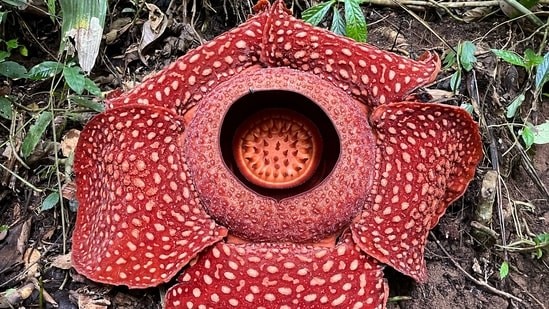Description

Disclaimer: Copyright infringement not intended.
Context
- The Rafflesia flower, renowned as the world's largest flower, is facing an escalating threat of extinction, as highlighted in recent research.
Details
Research Findings
- An international group of botanists conducted a comprehensive study of 42 known Rafflesia species and their habitats.
- Their findings revealed that the rapid disappearance of forest habitats, coupled with inadequate conservation strategies and protection plans, has put the Rafflesia at a significantly higher risk than previously understood.
- The research estimates that approximately 60 percent of Rafflesia species face a severe risk of extinction.
- Some species might become extinct before they are even scientifically documented, emphasizing the urgent need for further research and conservation measures.
Habitat Vulnerability
- Rafflesia's limited geographical range makes it particularly susceptible to habitat destruction, which further escalates its extinction risk.
- Climate change and human-driven environmental destruction compound these threats.

Global Conservation Initiatives
- Nations have made commitments to protect 30 percent of the world's land and seas by 2030 to mitigate species loss and ecosystem degradation.
- This research underscores the critical importance of such global conservation efforts in the face of climate change and environmental challenges.
About Rafflesia
Rafflesia, often referred to as the "corpse flower" or the "monster flower," is a fascinating and enigmatic genus of flowering plants known for producing the largest individual flowers on Earth.
Introduction to Rafflesia:
- Rafflesia is a genus of parasitic flowering plants that belong to the family Rafflesiaceae.
- It is native to Southeast Asia and is most commonly found in countries such as Malaysia, Indonesia, Thailand, and the Philippines.
- The genus is named after Sir Stamford Raffles, a British statesman and the founder of modern Singapore, who supported early botanical exploration in Southeast Asia.
Conservation Status:
- One species of Rafflesia is currently categorized as "critically endangered" by the International Union for Conservation of Nature (IUCN).
- This status reflects the severe threat to its survival due to factors like habitat loss and limited conservation efforts.
Unique Characteristics:
- Rafflesia is renowned for its distinctive features, including the largest flowers in the plant kingdom. These flowers can measure up to 3 feet (about 1 meter) in diameter.
- Unlike typical plants, Rafflesia lacks leaves, stems, and roots. It is entirely parasitic, relying on a host plant for nutrients and support.
- The flowers of Rafflesia are known for their foul odor, often resembling the scent of rotting flesh. This odor attracts carrion flies, which serve as pollinators.
Life Cycle:
- The life cycle of Rafflesia begins when the tiny, thread-like strands of the plant's mycelium (a fungal-like structure) invade the host vine.
- After a period of growth beneath the host vine, the flower bud of Rafflesia emerges and eventually blooms into a large, five-petaled flower.
- Once pollinated, the flower develops into a fruit containing numerous seeds. These seeds disperse and can potentially establish new Rafflesia plants on host vines.
Rarity and Endangerment:
- Rafflesia is considered rare and endangered due to various factors, including habitat loss, deforestation, and overharvesting.
- Conservation efforts are in place to protect Rafflesia species, and many areas where they are found have been designated as protected regions or national parks.
Cultural Significance:
- Rafflesia has cultural importance in some Southeast Asian communities. It is often viewed as a symbol of natural beauty and uniqueness.
- In some regions, Rafflesia is featured on stamps, coins, and tourist attractions.
Species Diversity:
- There are about 28 recognized species of Rafflesia, with new species occasionally discovered.
- Each species is characterized by variations in flower size, coloration, and morphology.

Conclusion
- Rafflesia flower, known for its extraordinary size and appearance, is under increasing threat of extinction due to habitat loss and insufficient conservation measures. Urgent international collaboration and conservation initiatives are crucial to protect these remarkable flowers from disappearing forever.
|
PRACTICE QUESTION
Q. Which of the following statements about Rafflesia is correct?
- Rafflesia is a photosynthetic plant with leaves and stems.
- It is commonly found in regions with temperate climates.
- Rafflesia flowers are known for their pleasant fragrance.
- The genus Rafflesia is entirely parasitic and lacks roots.
A) 1 and 3
B) 2 and 4
C) 3 and 4
D) 2 and 3
Correct Answer: B) 2 and 4
|
https://www.hindustantimes.com/world-news/rafflesia-flower-this-is-worlds-largest-flower-but-only-for-a-while-because-101695180087919.html












